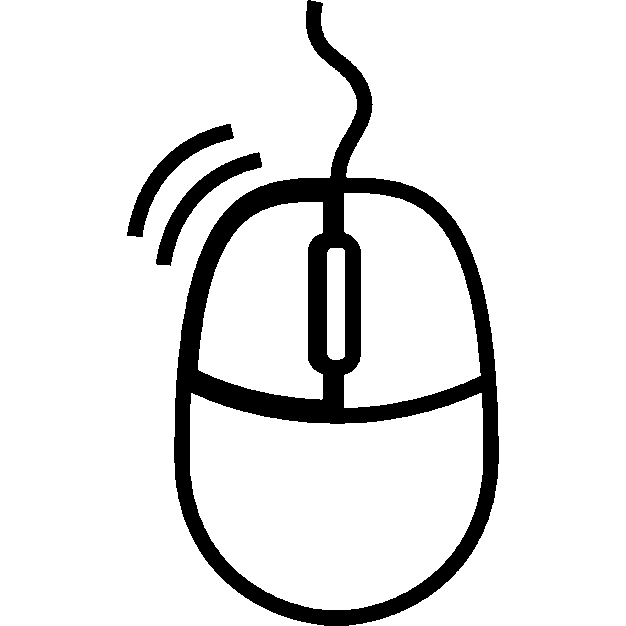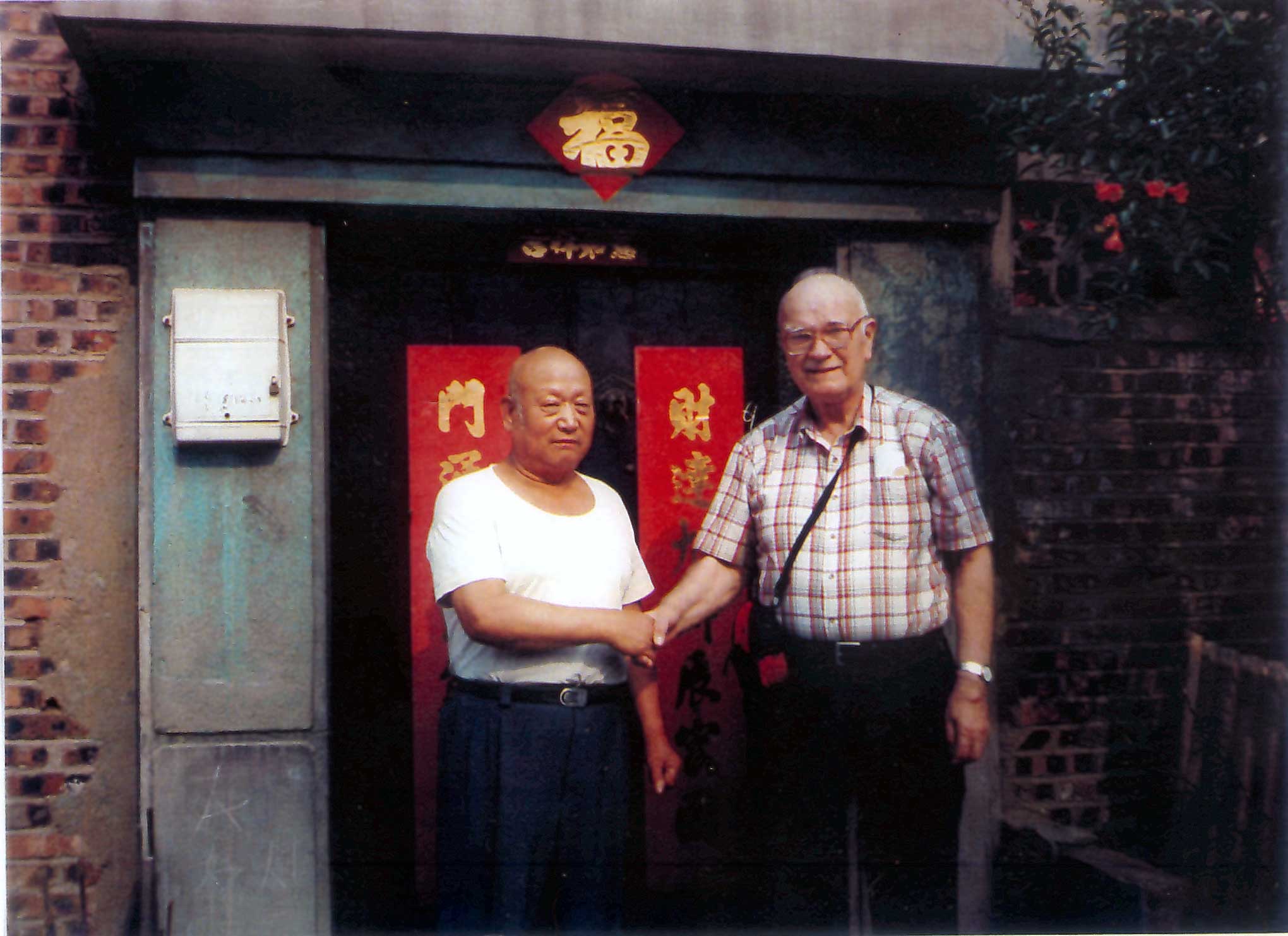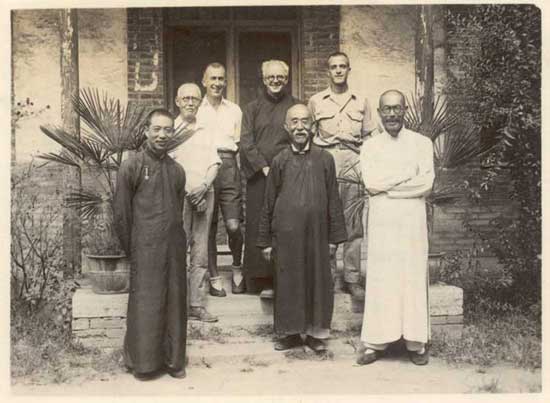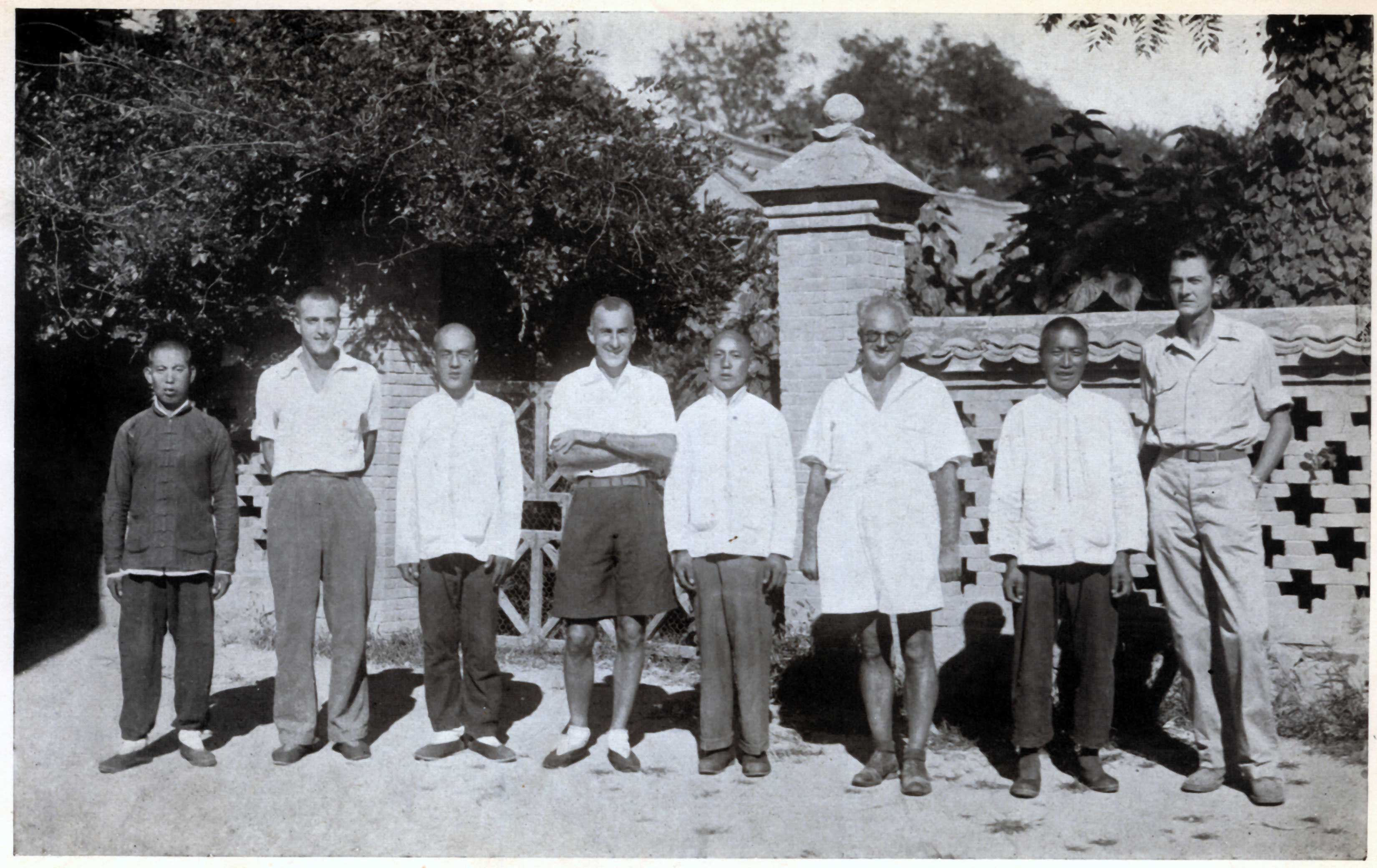
☛ ... the most recent messages are on top !
tapol@skynet.be [weihsien_camp]
To:weihsien_camp@yahoogroups.com
Wed, 25 Apr 2018 at 08:48
RE: [weihsien_camp] FW: Information request on internee at Weihsien
Dear Amaya,
… you wrote: “he was a bit of a giant … “
I guess that it is certainly he, that William A. Smith sketched … just after our liberation when the Americans came to the camp.
Just click here:
http://weihsien-paintings.org/StanleyFairchild/Sketches/M/p_bakery.htm
can you confirm?
Best regards,
Leopold
Mary Previte mtprevite@aol.com [weihsien_camp]
To:weihsien_camp@yahoogroups.com
Wed, 25 Apr 2018 at 01:49
Re: [weihsien_camp] FW: Information request on internee at Weihsien
These stories fascinate me —how prisoners were evacuated from Weihsien. We didn’t learn these stories for many years. We Taylor children had been flown out only three weeks after Liberation Day. So we were not there to see these later evacuations.
Our four Taylor siblings, Kathleen, Jamie, Johnny, and I, were perhaps the second group flown out of Weihsien. On September 10, 1945, six of us Chefoo School students were flown out in a U.S. cargo plane from the air strip not far from the camp. Because our parents had remained in China throughout the war, when the war ended, we children were not shipped to home countries like the United States or U. K. Instead, American military men flew us farther inside China to SiAn where we stayed overnight in an OSS (Office of Strategic Services) base. They showed us a Humphrey Bogart movie, “Casablanca,” and fed us ice cream. Kathleen and I slept in the tent of an officer. We were reunited with our parents the next day in the ancient walled city of FengHsiang—9/11/1945. Our family didn’t get to the United States until the summer of 1946.
How had we ended up in Weihsien? Like many students who had been attending the Chefoo boarding school before the war, after Japan attacked Pearl Harbor and Japanese took control of us and our school, we had become “enemy aliens.” When the Japanese wanted our school for a Japanese naval base, they shipped out our whole school—teachers, students, retired missionaries. We ended up in Weihsien. Many, many, many of our. Chefoo students were in Weihsien, separated from their parents. Children interned WITHOUT THEIR PARENTS! By 1945, we Taylor children had not seen our missionary parents for 5 1/2 years. That reunion night—September 11—we were introduced to a little brother, almost 5 years old.
What a family reunion!
Mary Taylor Previte
Albert de Zutter albertarthur@sbcglobal.net [weihsien_camp]
To:weihsien_camp@yahoogroups.com
Tue, 24 Apr 2018 at 21:18
Re: [weihsien_camp] FW: Information request on internee at Weihsien
Dear Leopold,
I did not realize that your family had to wait that long to leave the camp. Our family got out on that famous, one and only train on September 24 or 25th. I get confused because I associate our departure from Weihsien with my father's birthday on the 24th. By coincidence, our arrival in New York from Belgium also took place on September 24th or 25th. Again, I don't quite remember which, for the same reason.
Just a bit of trivia!
With regard to Mr. Wallis: My father also worked at the bakery, kneading the bread dough early in the morning.
My best to you,
Albert
From: Leopold_Pander
Sent: Tuesday, April 24, 2018 5:15 PM
To: 'weihsien_camp@yahoogroups.com'
Subject: FW: Information request on internee at Weihsien
Dear Amaya,
Thanks for your message …
I guess that you found my e-mail address via the http://www.weihsien-paintings.org website. On the website’s main-page, try using the search engine. There are quite a few references for your husband’s grandfather. This message is also forwarded to our Yahoo chat list. Hopefully, someone will write more ???
You also can have a look at
http://weihsien-paintings.org/HOAX/indexFrame.htm
… I doubt an ex-internee would have driven a train from Weihsien to Tientsin !!! The railroad tracks were blown up by the Chinese civil war raging outside. One train got thru to Tsingtao though, very shortly after our liberation and all the other internees had to be flown out. We left the camp on October 19, 1945, amongst the last ones to leave. I was four. On our way to the airfield standing with our luggage and many other folks on one of those army trucks, my dad told me to have a good look because we would never see this place again. Ever.
I came back in 2006!
Enjoy exploring the website and (of course) you are welcome to ask questions 😊
Best regards,
Leopold
From: Amaya Tamellin
Sent: Tuesday, April 24, 2018 9:30 AM
To: tapol@skynet.be
Hello,
Sent: Tuesday, April 24, 2018 9:30 AM
To: tapol@skynet.be
Subject: Information request on internee at Weihsien
Hello,
My name is Amaya and I am trying to collate information on my husband's grandfather, who was an intern at Weihsien camp during WW2. His name was George Charles Wallis, born in 1889.
I have found only one reference to him at Weihsien, about him managing a kitchen crew that baked bread. I would be thrilled to find out more about what he did in the camp, and the life he led. There is a myth running through my husband's family that he was a bit of a giant and a fearless man who drove the train of liberated interns to Tientsin, though I expect the truth never actually turns out to be as glamorous as the myth!
If you could help me in any way I would be immensely grateful.
Kind regards,
Amaya Tamellin
tapol@skynet.be [weihsien_camp]
To:weihsien_camp@yahoogroups.com
Thu, 5 Apr 2018 at 17:36
[weihsien_camp] new URL
http://weihsien-paintings.org/SuiShude/Documents/EddieWang/p_EddieWang.htmlhttp://weihsien-paintings.org/SuiShude/Documents/ZhangXingtai/p_ZhangXihong.html
enjoy 😊
… all the best,
Leopold
L PR tapol@skynet.be [weihsien_camp]
To:weihsien_camp@yahoogroups.com
Wed, 4 Apr 2018 at 17:18
[weihsien_camp] Weifang museum
Dear all,
I have recently received a message from Mr. Sui Shude and have given him permission on behalf of the Children of Weihsien (concentration camp 1943-45) to use large excerpts from our website book: “The Children of Weihsien”. All these texts come from our “Topica” messages and exchanged (on the web) during the past twenty years between all of us. All this, thanks to Natasha Petersen who started the whole thing not so long ago.
Best regards,
Leopold
Here is a copy of Mr. Sui’s message:
(don’t miss reading the two attachments) 😊
Greetings from Sui Shude, Weifang, China!
With your suggestion, I, and Zhang Hua, professor from Foreign Languages College of Weifang University, have
completed the translation of the book "The Children of Weihsien-1943-1945" into Chinese language. With
several times of editing and word polishing, it is ready for publishment. Each paragraph starts with: I
Remember:......in Chinese(your suggestion).
More, with your great idea and suggestion, we have added two people's memoirs, that is two Chinese people's "
I Remember......". One is from the parachutist of the "Duck Mission" team named Eddie Wong, another is from
Mr. Zhang Xihong, son of Mr. Zhang Xingtai who worked as a cleaner in the Weihsien Camp. I have added in
this email in English language so you can paste it to the Weihsien-Paintings website, as well as to add them to
the book. See the attached documents.
For publishing the Chinese version of the book "The Children of Weihsien-1943-1945", our local publishing
house need the permission of you and Natasha Petersen, to agree Mr. Zhang Hua to translate and publish the
book "The Children of Weihsien-1943-1945". Please just send me an e-mail to express your permission and
agreement for Mr. Zhang Hua, professor from Foreign Languages College of Weifang University to do so.
Except the text, we will not use any photos in this book. The book will be published in Chinese and we will not
sell it. It will be printed 1000 copies firstly, and kept in the Weihsien Internment Camp Memorial for distribution to
visitors, free of charge or free circulation. Also, it is much information for the Weihsien Internment Camp
Memorial and a contribution to that part of history.
Sui Shude.
Remarks by Wang Chenghan, Member of the Duck Mission Team to Liberate the Weihsien Concentration Camp
(August 17th, 2015)
I remember: On Aug. 17, 1945 at 9:30 AM, I parachuted into a sorghum field, a few hundred meters away from the Weihsien Concentration Camp.
I was the youngest of the 7 persons. In that year, I was only 20 years old. Among other members of the team, radio operator Peter Orlich was 21 years old while the other five were between 25 and 29 years old.
In those days, I just undertook a little work in the camp, as English-Japanese interpreter Tad Nagaki undertook the task of negotiating and contacting with the Japanese. My task was dealing with the interpretation related to Chinese people.
As with other mission teams named after birds, the “Duck Mission Team” was affiliated with O.S.S. China Headquarters(O.S.S.), i.e., the predecessor of Central Intelligence Agency (CIA). There were four work teams subordinate to it, namely, Special Operation (S.O.), Special Intelligence (S.I.), Morale Operation (M.O.) and School & Training (S&T).
I was graduated after studying in the “Interpreter Training Class of the Bureau of Foreign Affairs” in Chongqing for 25 days. On Apr. 25, 1945, I was sent to the “Interpreters’ Pool” in Kunming, and selected in S.O. by O.S.S. In Aug., shortly after I returned to O.S.S Headquarters in Kunming, Japan surrendered. I was reappointed to S.I. and transferred to a mission team led by Major Stanley Staiger.
To avoid Japan taking deadly revenge against the foreign nationals in the camp after it failed and surrendered, the primary task of the armies was rescuing the imprisoned foreign nationals and prisoners of war. On Aug. 16, 1945, our team flew from Kunming to the Forward Echelon. The next morning when we arrived at the Xi'an Airport, we finally knew that the task of our team was liberating foreign nationals in the Weihsien Concentration Camp. In the meantime, three mission teams respectively went to Shenyang, Beijing and Hainan Island to execute the same task.
Wearing parachutes, we boarded B-24 to Weihsien. We only knew our destination was the Weihsien Concentration Camp but did not know its specific location. So, our aircraft had to hover 2,000ft high in the sky, searching around the urban area of Weihsien. As we could not see the things below, the aircraft had to lower the flight altitude to 1,000ft, then to 500ft. Then, we found the airfield runway aboveground, as well as barrier walls, electrified wire netting and the compound surrounded by blockhouses, and saw a lot of people waving their shirts. We knew we had arrived above the camp. The major arranged the order of parachuting. He was the first one while I was the fifth one. Though the parachute could automatically puff out, I still felt a strong current of air knocking me out as I began parachuting. After my parachute puffed out, I finally realized that I was going to land in a sorghum field.
The 7 of us quickly gathered together, heavily-armed, planning to enter the camp. At that moment, many foreign nationals had rushed out of the gate. Without being stopped by the Japanese guards, they directly carried us through the gate. It was unexpected to us.
There were about 1,500 foreign nationals imprisoned in the camp. They had established an autonomous committee early. That day, our team members and the main members of the autonomous committee negotiated with the Japanese senior management, mainly requesting the Japanese to still take charge of the safety of the camp for the time being and provide material supplies for foreign nationals and requesting them to hand over the internal affairs of the camp to our team and the autonomous committee. Moreover, we required the Japanese to vacate their residence for the use of the team members.
The work schedule of the Duck Mission Team was packed. For the sake of the future take-off and landing of the aircraft, our team checked the airfield runway that afternoon, examined the medical conditions and the conditions of patients in the hospital, and installed communication facilities. The major discussed with the autonomous committee on how to solve the existing problems, etc. of the camp under the new situation.
On Aug. 27, ten B-29 large bombers flying from the U.S. military base in Okinawa airdropped a large quantity of necessities which mainly included foods, medicine, clothing and other articles for the foreign nationals. Then, such necessities were distributed to them. On Aug. 30, a team of over 20 men led by U.S. Colonel Weinberg came to the camp and took over the matter of sending the foreign nationals back to their countries. Then, the team belonged to Service of Supply (S.O.S.). After completing the handover procedures, our Duck Mission Team basically completed our mission.
(Provided by Sui Shude, Weifang Foreign Affairs Office)
Remarks by Zhang Xihong, 3rd Son of Zhang Xingtai, the Weihsien Camp Cleaner
(15:00 pm, August 17, 2005)
I remember, my father’s name is Zhang Xingtai. He was a sanitation worker in the Weihsien Concentration Camp. His work was to sweep away daily rubbish and he got in and out the concentration camp every day. He was familiar with the internees. In 1966 he died. My eldest brother Zhang Xiwu and second brother Zhang Xiguang helped father to make cleaning in the concentration camp. At that time, I was still young and all of my understanding about the concentration camp came from my father’s words.
Originally my father had been running small dealings in the Ledaoyuan and he knew Dr. Davies well, who was the headmaster of Guangwen Middle School. Later the Japanese set up the concentration camp in Ledaoyuan. My father and two elder brothers became sanitation workers there. Dr. Davies was also interned in the camp and was selected to be a managing personnel because he is familier with the situation of Weihsien. The interned foreigners lived a hard life without enough food and medicine. My father sympathized with them and detest the cruelty of the Japanese. Dr. Davies secretly contacted and asked my father to take letter to the local pastor Mr. Huang Lede for measures to help the internees. Later the local people of Weihsien raised a lot of money, bought a large quantity of materials in name of the Red Cross and sent into the concentration camp through Qingdao Agency. Thus the life of the internees became much better.
Afterwards Dr. Davies asked my father to try to contact with local anti-Japanese guerrilla forces. My father inquired everywhere and with the touch with a sanitation worker Yang Ruilan in the hospital of Ledaoyuan, through her husband Wang Shaowen he finally contacted with the guerrilla forces. With the help of the guerrilla forces, Arthur W. Hummel Jr. and Tipton escaped from the camp to the guerrilla forces and contacted with the US Embassy and took situations of the camp to it.
The day after their escape, the Japanese searched all around for them and happened to meet my father and eldest brother. The Japanese arrested my eldest brother. My father went to stop them but was beaten onto the ground by the Japanese’s buttstocks. The Japanese forced my eldest brother with guns and searched for a long time in the corn field to the north of the camp. My eldest brother was still young and was too frightened to say a word. At last the Japanese had to give up and set my eldest brother free. After the liberation of the concentration camp, Mr. Arthur W. Hummel Jr., Mr. Tipton and Mr. Raymond Jaegher came back and visited my father and had a photo taken as a memento. During the war years, what my father and two brothers did for the concentration camp was kept secret for personal safety. Neither the interned foreigners nor the other family members knew much about that. In 1983 when Mr. Arthur W. Hummel Jr. was working as Ambassador to China, he came to Weifang and searched for my father but failed. In this June the British man Dr. Norman Cliff made a special visit to my home for my father’s situation.
(Provided by Sui Shude, Weifang Foreign Affairs Office)
[click on the pictures]
"I, (Norman Cliff) was taken to meet Zhang Xihong, whose father and uncle were "cesspool coolies". These brave men came daily into the camp to remove the night soil and they also helped with the escape of two men from the camp."
N.B. from Leopold (webmaster)
- Who is Dr. Davies? - ... was he a doctor or a minister? His name is not written on the wall of "rembrance" in the Courtyard of the Happy Way gardens. The head of the "Committee" at the time of the escape was: Ted McLaren.
- The local pastor, Mr. Huang Lede (mentioned in the text above) is he not the Protestant minister in the first photo (hereunder) by the name of Joseph Tchang? or Xiang?
Emmanuel Hanquet (also a R.C.priest) told me that - on that photo - it was Joseph Tchang (or Huang Lede) who had the authority of contacting the guerillas on behalf of Raymond deJaegher who then informed the head of the camp committee: Mr McLaren.
All this had to be kept "Top Secret" of course.
- Yang Ruilan and husband Wang Shaowen living in the camp (?) ... are they not simply Raymond deJaegher, the Roman Catholic priest that scheduled the whole escape scheme with Laurie Tipton in the first place? (In Gilkey's book, he was described as "the discreet missionary" (page 204) in charge of the filthiest chore one can imagine: keeping the latrines clean.) - 
- Copies of the original documents about Tipton and Hummel's escape were collected by Norman Cliff and safeguarded in his scrapbooks now stored at the Imperial War Museum in London. [click on the blinking smiley] - 
The "ESCAPE" team,
From left to right
Larry Tipton//Father Raymond de Jaegher//Arthur W.Hummel
Centre front
Father Tchang// … and his Chinese friends who helped L.Tipton and A.Hummel to find their way to the Chinese guerrillas …
The "Liberation Group"
from left to right ---
-?-, Arthur Hummel, -?-, Laurie Tipton, -?-, Father Raymond deJaegher, Zhang Xihong's father and --- Roy Tchoo.
Angela Elliott angelalousia@yahoo.ca [weihsien_camp]
To:weihsien_camp@yahoogroups.com
Sun, 1 Apr 2018 at 17:08
Re: [weihsien_camp] RE: Trying to trace an old family member who was in Tsingtao in the 1920s
1115 pm. Sun apr 1. Georgetown. Penang. MalaysiaHi
What a story - so interesting to add to the records .... so glad more info is coming
In.. —- we/ll keep Leopold well occupied ...
Cheers Angela
Tara Gully-Hightower taragullyhightower@yahoo.com [weihsien_camp]
To:weihsien_camp@yahoogroups.com
Sun, 1 Apr 2018 at 16:11
Re: [weihsien_camp] RE: Trying to trace an old family member who was in Tsingtao in the 1920s
Yes, Thank you very, very much for posting this Leopold!
Tara Gully-Hightower
Mary Previte mtprevite@aol.com [weihsien_camp]
To:weihsien_camp@yahoogroups.com
Sun, 1 Apr 2018 at 16:08
Re: [weihsien_camp] RE: Trying to trace an old family member who was in Tsingtao in the 1920s
What a fascinating account —a wonderful addition to your Weihsien web site, Leopold! Many of our Chefoo School classmates, who were American nationals, were also shipped out on the Gripsholm, in a prisoner exchange.
Thank you.
Mary Taylor Previte
tapol@skynet.be [weihsien_camp]
To:weihsien_camp@yahoogroups.com
Sun, 1 Apr 2018 at 09:08
RE: [weihsien_camp] RE: Trying to trace an old family member who was in Tsingtao in the 1920s
Hi 😊
Happy Easter to y’all.
Russian Easter is next week so, we will be celebrating that too.
Thanks to Tara, we have a new add on the Weihsien-Paintings’ website … here is the “URL” :
http://www.weihsien-paintings.org/JamesRHightower/p_Tara1.html
… and if you scroll to the bottom of that page you will find a “printer-friendly version” : (click on the printer pictogram)
http://www.weihsien-paintings.org/JamesRHightower/Tara(WEB).pdf
Best regards,
Leopold
tapol@skynet.be [weihsien_camp]
To:weihsien_camp@yahoogroups.com
Wed, 28 Mar 2018 at 15:30
RE: [weihsien_camp] RE: Trying to trace an old family member who was in Tsingtao in the 1920s
Dear Tara,
Yes, certainly 😊
You can send me all your data to: tapol@skynet.be. If too voluminous for e-mail, you can transfer your data in a “cloud” and send me the URL or in an envelope at my snail-mail address:
Leopold Pander,
Sentier du Berger, 15
1325 Corroy-le-Grand
Belgium
Oh! Yes ! …. Do not send original documents !!!
Thanks in advance,
Leopold
Tara Gully-Hightower taragullyhightower@yahoo.com [weihsien_camp]
To:tapol@skynet.be [weihsien_camp]
Wed, 28 Mar 2018 at 15:13
Re: [weihsien_camp] RE: Trying to trace an old family member who was in Tsingtao in the 1920s
Hello Mr. Pander,
My grandfather, James Robert Hightower, a visiting Ph. D. student from Harvard at Peking University was in the camp for the first 6 months of internment. He passed away 11 years ago. I have a short section of an interview (that has been transcribed) where he mentions his time in the camps and describes his experiences. I am happy to send you this. I also have a PDF. of newspaper clippings about his return from the camp. I would love to have it preserved somewhere. Please let me know if you are interested.
Thank you! Tara Gully-Hightower
tapol@skynet.be [weihsien_camp]
To:'Peter Hayward',weihsien_camp@yahoogroups.com
Wed, 28 Mar 2018 at 14:52
[weihsien_camp] RE: Trying to trace an old family member who was in Tsingtao in the 1920s
Dear Peter,
Thank you for your message.
This Weihsien-Paintings’ website started about twenty years ago very unexpectedly I must admit. In those days, the idea of assembling all our documents in a same place seemed to be a good idea and I (four and a half years old in 1945) volunteered to arrange it all in a single website. I had plenty time to spare and learned quite a lot too.
I received help from England (Norman Cliff), Belgium (Emmanuel Hanquet), Australia (Joyce Bradbury – Alexander Strangman), New Zealand, Canada, the USA, Holland, etc. Today, many of all these fine people are long gone and some ― for I do not know what reason ― no longer respond to e-mails about WWII and Weihsien in particular.
I am still alive and keen to add “whatever” can be of interest to this period of our history.
To help you, I am forwarding this message to our Weihsien chat list on Yahoo hoping that maybe somebody will be able to give you more info.
Best regards,
Leopold Pander.
(Belgium)
From: Peter Hayward
Sent: Wednesday, March 28, 2018 1:27 PM
To: tapol@skynet.be
Dear possible Tsingtao connectees,
Sent: Wednesday, March 28, 2018 1:27 PM
To: tapol@skynet.be
Subject: Trying to trace an old family member who was in Tsingtao in the 1920s
Dear possible Tsingtao connectees,
I am sending this email in the hope that I can make contact with Joyce Dorothy Bradbury, anybody who knows of her whereabouts, or anybody who was connected with Tsingtao in the 1930s.
My name is Peter Hayward and a friend of the family is conducting some fairly exhaustive research on the family history. The link is that it would seem that a relative of mine, Albert Edward Hayward, was probably resident in Tsingtao in the 1920s but nothing known of him after 1930.
"The information that has been ascertained is that he married a Gertrude Gladys Sherman in Shanghai on 24/8/1918. The couple adopted a daughter in China on 15/10/1926. She was born Irene Matilda Burke-Close in Chefoo, China on 11/3/1924 and known as Joan Hayward after adoption, and later as Joan Coghill when Gertrude Gladys remarried after the divorce. She was educated at St Giles British School in Tsingtao and was evacuated to join Gertrude Gladys in Australia on 2/12/1941. She died in Australia in 2003. Albert Edward and Gertrude Gladys divorced in China on 27/10/1930. She remarried Alexander Coghill in Shanghai on 15/11/1930, just a couple of weeks after the divorce. She died in Australia in 1956."
I have tried to do my own research and naturally came across your web site and Joyce Bradbury's fascinating account of her time in Tsingtao and cannot fail to think that she or somebody she might have known might have in turn known something of that relative of mine.
If anybody can shed any light on this matter then naturally I would be delighted to make contact.
The kindest of regards and best of intentions,
Peter Hayward








